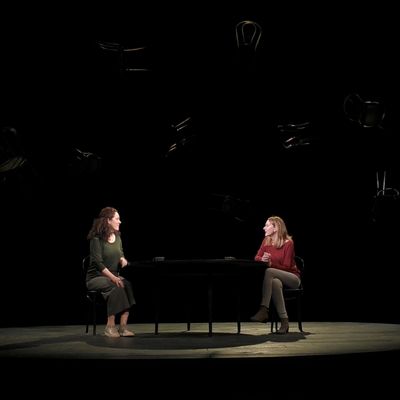
The Irish playwright Mark OÔÇÖRowe doesnÔÇÖt bring his work to New York often, but when he does, the seats catch fire. His Howie the Rookie has been performed in New York three times in the last 20 yearsÔÇöeach time scorching the curtainsÔÇöand anyone who saw his string-of-monologues Terminus in 2008 is probably still waking in the night, screaming. But our view of the man has been confined to the little windows those shows allow. They made him out to be the bareknuckle Homer; his dense, poetic, Irish slang-filled arias thick as mud in your throat. The miracle of international streaming, though, pushes that window wider. Thanks to a co-production with St. AnnÔÇÖs Warehouse, American audiences can see a quieter (but still disquieting) side of the playwright. Live from Dublin on your computer screen, itÔÇÖs a superb performance of The Approach.
The play takes place entirely at a caf├® table, though for pandemic purposes the table has been extended to a six-foot diameterÔÇöa dark expanse, cups of tea floating like lily pads. DublinÔÇÖs Project Arts Centre stage yawns in the background, its black expanse hung higgledy-piggledy with other chairs, as if the caf├® has frozen mid-explosion. (Sin├®ad McKenna designed the set.) Certainly in this play, time has slowed and jellied. Each scene consists of a meeting between two friends, different configurations of a trio that was once close: Cora (Cathy Belton) and Anna (Aisling OÔÇÖSullivan) catch up after a long lull in their relationship; then Cora reminisces with Denise (Derbhle Crotty); then sisters Anna and Denise hash out an old betrayal. Months and even years elapse between meetings, giving allegiances time to shift. Each ÔÇ£deep chatÔÇØ ends with huge proclamations of affection, though we learn not to take them at their word. Men in their lives come and go, but this promiseÔÇöweÔÇÖll get together soon!ÔÇöis reliably wrong.
The play is manifestly a showcase. OÔÇÖRowe wrote it for these three specific actors, each one a soft-voiced cannon. OÔÇÖSullivan is very still, but her emotions surge like magma; Crotty is warm enough to heat your screen; Belton has perfected a shy shrug-and-smile that will make the hair on your neck stand up. Their conversation ripples and surges and interrupts itself in the way that talk really does, creating a hypnotizing rhythm that can hide bombs inside it. The text does therefore have the same breakneck momentum as Howie the Rookie and Terminus, though here OÔÇÖRowe is writing duets rather than enchained monologues. (His long career in screenwriting, including work on the television adaptation of Sally RooneyÔÇÖs Normal People, may explain his relatively conventional touch in this newer work. Terminus featured a demon made of worms. This play does not.)
But just because the chat is naturalistic doesnt mean the effect isnt just a little  strange. ORowe sometimes blurs the lines between the womens stories. As friends, they obviously share a past, but in a few uncanny moments, they seem to have shared a biography too. Each woman claims shes had a boyfriend who makes crosswords as a love tokenclues that are inside jokes, answers that are memories or declarations of love. Yet they cant have all had the same experience, surely? It teaches us to think of the play as a game too, but one in which the answers keep changing. One key to the game is absence. ORowes eye always selects for some loss: The women remember a window seat in a much-missed restaurant; theres a hole in Coras mouth where a tooths been knocked away; Cora frets over a book that hasnt been purchased. Each time, ORowe makes us think of a gapa space on a shelf, a black square on the crossword. The long pauses between scenes are as dark as those gaps, and certainty falls into them. There are three actors in the show, but we grow unsure that they represent exactly three women. Is there some number between two and three? Then theres a fourth, a troubled girl from their past, who sometimes shows upnever on stage, but in the stories, out in the dark spaces.
The Approach is actually a 2018 play. It wasnÔÇÖt written with the pandemic in mind, but it fits itself beautifully to the time. Its stillness plays well onscreen: OÔÇÖRoweÔÇÖs direction and the actorsÔÇÖ virtuosity reward the cameraÔÇÖs coming close, letting us see details of expression that even a front-row theatergoer might miss. Aesthetically, too, the real world has caught up to OÔÇÖRoweÔÇÖs carefully laid weirdness, like the sense of time slipping.


